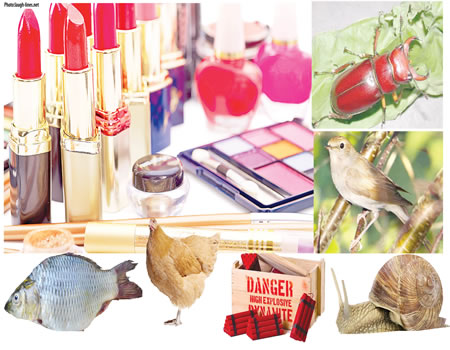Today, beauty is not only diverse but also weird, and not just in terms of tendencies but also ingredients in skin care products. According to www.brightside.me, below are ten weird ingredients found in common beauty products.
Whale vomit (ambergris)
Actually, ambergris is a substance produced in a whale’s digestive system. Even though it’s called ‘whale vomit,’ it’s more commonly pooped than vomited. This by-product is also called a “floating gold” due to its value in the cosmetic industry. For many years it was used in perfumes to make the scent last longer. Nowadays companies use a less expensive synthetic variant.
Snail slime (mucin)
Apart from being a food speciality, snails are also valued for their gooey secretion (mucin) which is rich in proteins, glycolic acid, and elastin that are widely used in facials due to their regenerative and moisturising properties. They are highly effective for those who want to turn back time and smooth wrinkles and fine lines.
Placenta (afterbirth)
A number of beauty products already contain animal placenta extracts, claiming to offer all sorts of anti-aging benefits including skin elasticity and collagen production. The skin-related advantages might be proven, but there’s very little evidence to show that eating the placenta will benefit your health.
Fish scales (guanine)
Fish scales, also known as guanine, is a pearlescent substance that is often added to nail polishes, lipsticks, and shampoos to give them that shimmery look. So, next time take a look at the label and maybe you’ll find it there.
Beetle juice (carmine)
We bet that you do have at least one red lipstick in your beauty bag. Do you know what makes its colour so juicy red? It’s the actual extract of crushed beetles called cochineal. Carmine dye is the bright red pigment produced by the crushing of dried female cochineal into powder. Until recently, cosmetic and food brands weren’t obligated to identify the actual source of their colours, using deceptive terms like “artificial colours” or “natural red pigment” and some others. Nowadays though, it is required to mention the pigment as cochineal or carmine because some people have severe allergic reactions to it. So, if eating insects is not a part of your traditional diet, this is the perfect time to start reading your labels.
Baby foreskin (fibroblasts)
Some beauty companies do report including human foreskin fibroblasts made from circumcised baby foreskin into their skincare products promising to give the consumers a young and radiant look. It may actually be filled with everything we begin to lose with age, all possible antioxidants, proteins, collagen, elastin, etc., but there’s just too much of an ick-factor here, no?
Ladies, before you bare that flesh…
Bird poop
Bird excrement, mostly from nightingales, is a popular Japanese beauty product taken from geisha times to help to maintain their flawless and porcelain complexions. Bird poop skincare products are exported out of Japan and are quite pricey – so why not just to rest under a nightingale’s nest and wait for nature to call?
Yeasts
Many beauty brands are using yeast because of its hydrating, repairing, and skin brightening attributes. However, due to the lack of substantial pro/con research, those statements are most of the time simply promotional claims. Also, it’s important to know that not all types of yeast are good for consumption. Therefore, read the product’s ingredient label before buying or applying.
Chicken bone marrow (glucosamine)
Glucosamine is a building block for skin-radiance. It can be found in many animal’s skeletons, but apparently chicken bone marrow is a great source for it. It works as a moisturising, enhancing, and anti-inflammatory agent for topical skin care products.
Dynamite
Diatomaceous earth (DE) is one of the components that make up dynamite. Due to its porous properties, DE serves as a pretty good abrasive and is found in many soft facial scrubs, toothpastes, and powders. At the same time, its other purpose is to stabilise nitroglycerin for transportation when in dynamite form.
Faceb




